TAGGED AS: Disney, Sci-Fi, science fiction, streaming, television, TV
No matter how long it may have been between seasons of The Mandalorian – and The Book of Boba Fett – redemption is first and foremost on the mind of Din Djarin (Pedro Pascal), so it makes sense the series would swiftly set foot on Mandalore. And with season 3’s second episode, “Chapter 18: The Mines of Mandalore,” we get a glimpse of the planet many years after the Empire set it ablaze in the Night of a Thousand Tears and, perhaps, a notion of its potential future.
But what could that mean for the season and the question foremost on our mind: Why did Bo-Katan Kryze (Katee Sackhoff) allow Djarin to leave with the Darksaber in the season 2 finale and last week’s episode? Let’s dive into the Mines and see if we can’t get closer to an answer and discover what survives in the Living Waters.
Spoiler alert: The following reveals details from The Mandalorian season 3 episode “Chapter 18: The Mines of Mandalore.” Stop reading here if you have not watched the episode and wish to avoid spoilers.

(Photo by Lucasfilm Ltd.)
Although Mandalorians present as a grounded warrior race, they appear to be bound by a level of mysticism, prophesy, and superstition to rival the Jedi Order. As an example, Djarin is the first Mando to visit the ancestral homeworld since the Night of a Thousand Tears. The presumed condition of the planet in previous episodes ranged from total obliteration — à la Alderaan — to, as Boba Fett (Temuera Morrison) described it, a world “turned to glass.” No matter the truth of the matter, the trauma of the Great Purge left the surviving Mandalorians believing their home was poisoned and cursed; a belief so pervasive, even Bo-Katan could not muster the will to go planetside.
And though Djarin, a child of the Watch, believes in Mandalorian mysticism more strongly than Bo-Katan, he quickly proves (following a detour to Tatooine) the air is breathable and that, in his own words, “Bo-Katan was right.”
When she makes planetfall, Bo-Katan also discovers Alamites, a scavenger species who populated the wastelands between Mandalore’s domed cities, also survived the Purge. Her wonder about what else may have endured is quickly tempered as she and Grogu travel the ruins of the planet’s once great capital, Sundari, to rescue Djarin.
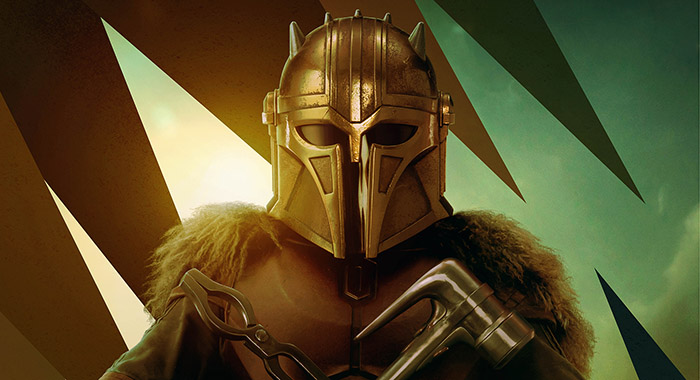
(Photo by Lucasfilm Ltd.)
The condition of the city and the world is consistent with the prophecy as spoken by the Armorer (Emily Swallow) in episode 5 of The Book of Boba Fett. As she explained to Djarin at that time, a person who wins the Darksaber in combat will have the authority to rule all of Mandalore, but to claim it without that trial will doom the planet and scatter its people to the four winds. One can’t help but think this very prophecy rings in Bo-Katan’s mind as she walks the ruins of her home. Her claim to the Darksaber was not from combat, but from the fact Sabine Wren (voiced by Tiya Sircar on Star Wars Rebels and to be played by Natasha Liu Bordizzo on the upcoming Ahsoka series) handed it to her in an attempt to settle an ongoing internal strife among the clans.
Bo-Katan mentions infighting as the reason the Empire was able to overwhelm the planet, but as she also subsequently tells Djarin that she recited the Creed as part of a royal ceremony, it’s clear she knows the legends and superstitions as well as he does. Did she doubt her claim in that crucial moment aboard the Imperial Remnant cruiser because Mandalore fell while she “illegitimately” held the Darksaber?
More on that in a moment. But first, considering her glance at the destroyed dome of Sundari, we also have to wonder if anything can be saved on Mandalore. Kalevala, in the same system, seems full of resources and a place to start anew. But as rites and superstitions permeate even the most agnostic of Mandos, will restoring the planet be a requirement for any sort of future of a united Mandalorian people?
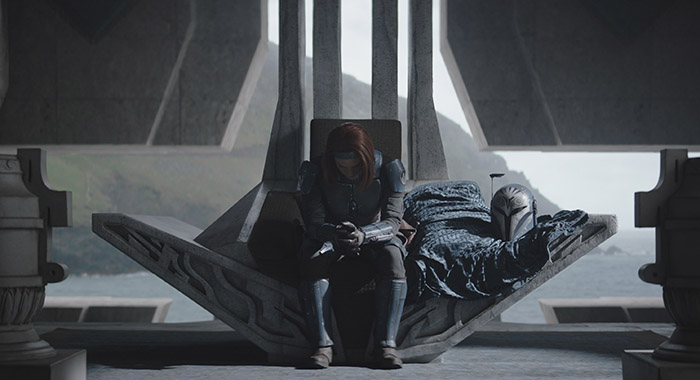
(Photo by Lucasfilm Ltd.)
With the questions above in mind, we turn our attention to Bo-Katan’s rescue of Djarin. Captured by a droid with organic parts interested in collecting his blood and/or bone marrow, he dispatches Grogu to get aid from Bo-Katan, who swiftly moves to action once she realizes he is in trouble. And when she comes upon the droid, the ensuing fight places the Darksaber in hands, where she proves more adept at the weapon than Djarin.
Of course, that opinion is aided by the swiftness of the fight. Djarin’s previous attempts to use the blade in The Book of Boba Fett lasted a little bit longer and saw him buckle under its weight. But they also provide some insight into why she might be more accomplished with it. Back in Boba Fett‘s fifth episode, the Armorer attempts to train him in sword arts, admonishing him for both wielding it with physical strength alone and “fighting against the blade.” The result: it gets heavier with each stroke. Even Sabine, when she briefly possessed it, remarked on its heaviness.
Despite the brief battle with the droid, we’re inclined to believe Bo-Katan trained with the Darksaber to achieve the mental clarity necessary to use it as a weapon and not just as a badge of office. Or, perhaps, it was all just instinct in the moment.
Either way, we presume she hands the blade back to Djarin because, once again, she possessed it without a proper fight. Why? Because she believes in the prophecy. Without that fight, she invites another doom among her people. But what prevents her from just dueling Djarin for it?
That is something the characters will have to settle soon should either find themselves interested in restoring the planet or making the system a home for their kind.

(Photo by Lucasfilm Ltd.)
And since this episode is doggedly about Mandalorian religion, let’s take a look at Djarin’s conviction in this matter. Last season, we wondered if, perhaps, taking off his helmet would lead to a more evolved opinion of what it means to be Mando. Having now adventured with Bo-Katan and Boba Fett, we thought his worldview might expand beyond the rigid dogma of the Watch — and make no mistake, dogmatic extremism is one of Star Wars’ truest villains.
Nevertheless, Djarin seeks redemption in the eyes of the Watch and the Creed. His journeying in the two years or so between seasons has changed none of his convictions, and instead, he’s seemingly spent the time since Boba Fett looking for proof that he could visit the Living Waters and atone for removing his helmet. Once he and Bo-Katan come upon the waters, he views them with reverence, while she still perceives them as a place for boring field trips.
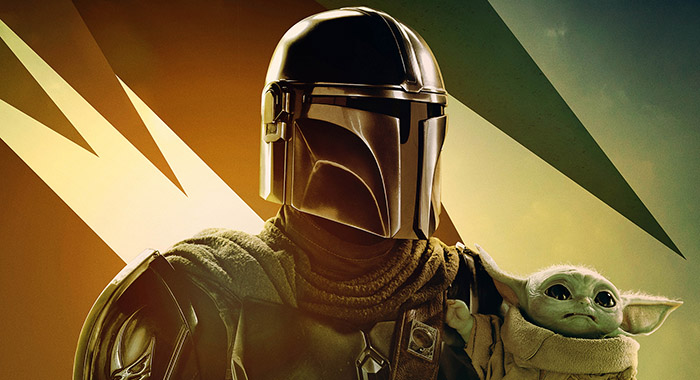
(Photo by Lucasfilm Ltd.)
Although Star Wars has spent 45-plus years warning about stringent adherence to any creed, we sympathize with Djarin’s motivation here. The Watch is the only community he has ever known and although its willingness to discard him for breaking a silly rule should ignite a suspicion about their Ways — clearly, pog soup is not served among them as it would invite its members to remove their helmets — he nonetheless needs that sense of community, even if he is only among them for short stints between bounties.
His devotion to the community, though, requires some exploration of the Watch itself as the Armorer’s belief in the Creed precludes any forgiveness except the one it prescribes. The fondness he feels for the covert is not reciprocated, even when its numbers dwindled to just three. And now that it’s been reinforced with a crop of new foundlings, will he truly find a welcome home even if he is forgiven by Creed?
Meanwhile, we also have to wonder if Bo-Katan’s faith has been strengthened by what she saw in the Living Waters.
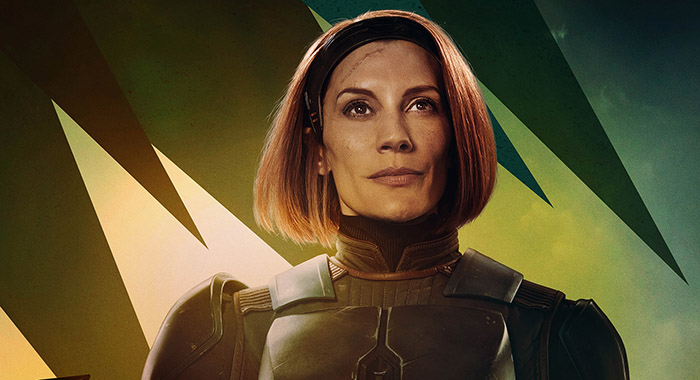
(Photo by Lucasfilm Ltd.)
As laid out by the Armorer in that fifth Boba Fett episode and mentioned in the story recap of this week’s episode, the return of a Mythosaur to Mandalore is said to presage a new era for Mandalorians. And although Bo-Katan entered the chamber of the waters believing nothing lived there, she now knows the truth: a Mythosaur lurks in its depths.
As she mentions, the Mythosaur is a key part of Mando mythology dating back to the time of Mandalore the Great and the source of the race’s symbol, a skull of the great beast. Back in the first season, Kuiil (Nick Nolte, pictured below) even admonishes Djarin’s inability to ride a Blurgg by comparing him to the Mandalorians of old who could tame Mythosaurs.
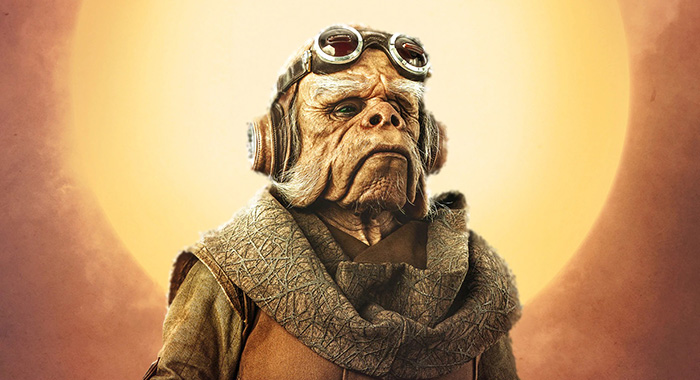
(Photo by Lucasfilm Ltd.)
That a specimen would be found was inevitable, but what remains to be seen is just who will tame it. Or, perhaps, if taming it and ushering in that new age is something either character is interested in accomplishing. Djarin, for his part, got what he wanted; the quest for redemption has ended as he has now bathed in the Living Waters. But it is possible the experience has changed his outlook on doing more than questing. Bo-Katan’s derisive suggestion last week that he should rule the Mandalorians takes on a new light as another part of prophecy has seemingly been fulfilled. And, maybe, it means our question about their possible duel will be answered next week.
Beyond the succession issue, though, there are still the matters of restoring a portion of the planet to a livable state and, more pressingly, uniting the clans, the Watch, and other more agnostic factions under the Mythosaur banner again. From what we know of Djarin, this might be too much of an ask. Bo-Katan, meanwhile, may no longer have the heart for such work unless she’s become more inclined toward religion, prophecy, and superstition.
And it seems belief is the key to bringing the factions together. But will it be the Watch’s philosophy that wins in the end?
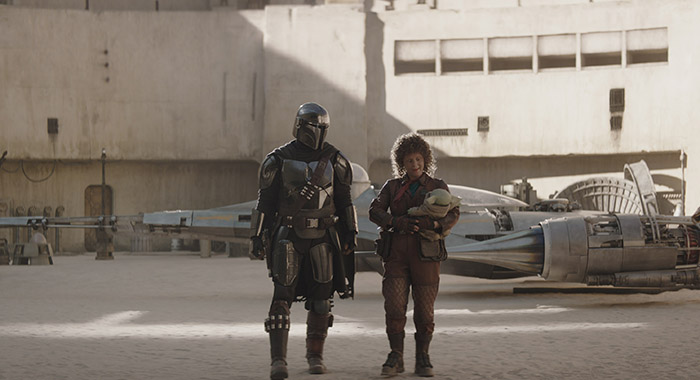
(Photo by Lucasfilm Ltd.)
• Peli Motto’s (Amy Sedaris) mention of R5-D4’s service to the Rebellion partially canonizes an Expanded Universe story, Rae Carson’s “The Red One,” in which R2-D2 convinces him to overload his own motivator when Owen Lars (Phil Brown) buys the droid in the original Star Wars. As explained in the tale, R2 confides in his fellow astromech droid that he is carrying information vital to the Alliance, and though R5 is desperate to escape the Jawas, he eventually agrees to sabotage himself. Other tales also suggest more direct contact with the Rebellion.
• Peli’s suggestion that Djarin is back on Tatooine to “take out Boba Fett” leaves us wondering if, perhaps, the clone’s administration of Jabba’s cartel has hit another snag or if he’s given up on the idea of being an honorable and fair crime lord.
• Kalevala, homeworld of Clan Kryze, is named after the Finnish oral tradition eventually written down by 19th century poet Elias Lönnrot. The legends proved influential on a young J.R.R. Tolkien, who would set out to make an epic of his own. It is unclear, though, if the tales of a mythical land and its life-sustaining “sampo” will be more than just a hat-tip to epics of the past.
• While the N-1 fighter continues to be a “wizard” of a ride, this episode highlights the cramped conditions Djarin and Grogu share — where does the pod go when not in use? We can’t help but wonder if a larger mobile home like the Razer Crest isn’t in their future.
• Grogu’s flips and Force-push indicate some learning in the time he spent with Luke Skywalker (Mark Hamill), but will his powers diminish as Ahsoka Tano (Rosario Dawson) suggested?
![]() 84%
The Mandalorian: Season 3
(2023)
premieres on Wednesday, March 1 on Disney+.
84%
The Mandalorian: Season 3
(2023)
premieres on Wednesday, March 1 on Disney+.
Thumbnail image by Lucasfilm Ltd.